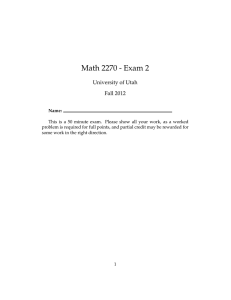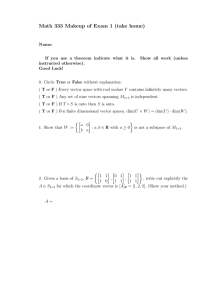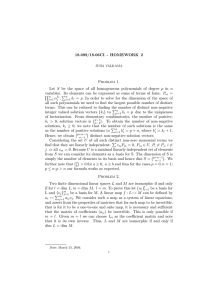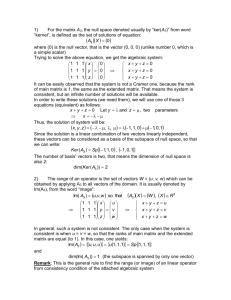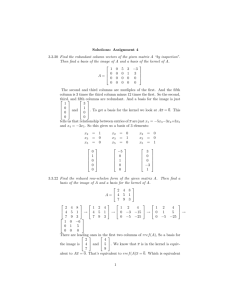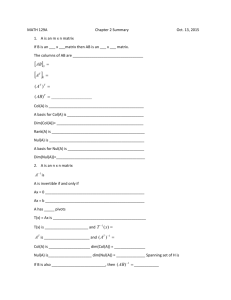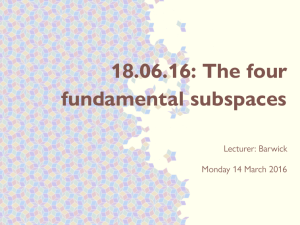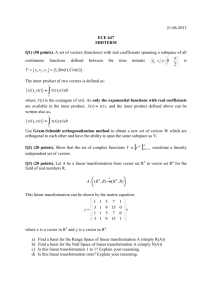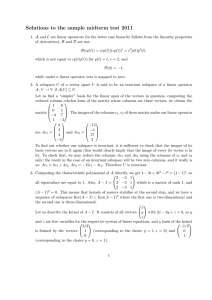PILOT Learning Linear Algebra Fall 2014 Problem Set 2 1
advertisement
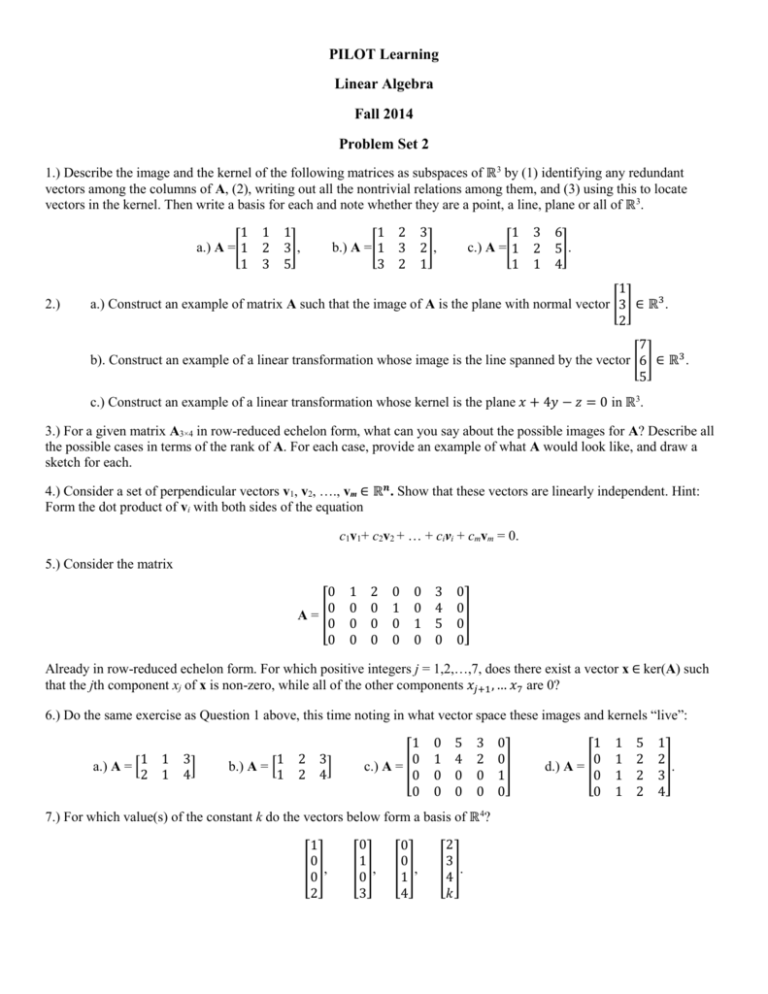
PILOT Learning Linear Algebra Fall 2014 Problem Set 2 1.) Describe the image and the kernel of the following matrices as subspaces of ℝ3 by (1) identifying any redundant vectors among the columns of A, (2), writing out all the nontrivial relations among them, and (3) using this to locate vectors in the kernel. Then write a basis for each and note whether they are a point, a line, plane or all of ℝ3. 1 a.) A =[1 1 2.) 1 1 2 3], 3 5 1 2 3 b.) A =[1 3 2], 3 2 1 1 c.) A =[1 1 3 6 2 5]. 1 4 1 a.) Construct an example of matrix A such that the image of A is the plane with normal vector [3] ∈ ℝ3 . 2 7 b). Construct an example of a linear transformation whose image is the line spanned by the vector [6] ∈ ℝ3 . 5 c.) Construct an example of a linear transformation whose kernel is the plane 𝑥 + 4𝑦 − 𝑧 = 0 in ℝ3. 3.) For a given matrix A3×4 in row-reduced echelon form, what can you say about the possible images for A? Describe all the possible cases in terms of the rank of A. For each case, provide an example of what A would look like, and draw a sketch for each. 4.) Consider a set of perpendicular vectors v1, v2, …., vm ∈ ℝ𝒏. Show that these vectors are linearly independent. Hint: Form the dot product of vi with both sides of the equation c1v1+ c2v2 + … + civi + cmvm = 0. 5.) Consider the matrix 0 0 A=[ 0 0 1 0 0 0 2 0 0 0 0 1 0 0 0 0 1 0 3 4 5 0 0 0 ] 0 0 Already in row-reduced echelon form. For which positive integers j = 1,2,…,7, does there exist a vector x ∈ ker(A) such that the jth component xj of x is non-zero, while all of the other components 𝑥𝑗+1 , … 𝑥7 are 0? 6.) Do the same exercise as Question 1 above, this time noting in what vector space these images and kernels “live”: 1 a.) A = [ 2 1 3 ] 1 4 1 b.) A = [ 1 2 3 ] 2 4 1 0 c.) A = [ 0 0 0 1 0 0 5 4 0 0 3 2 0 0 7.) For which value(s) of the constant k do the vectors below form a basis of ℝ4? 1 0 [ ], 0 2 0 1 [ ], 0 3 0 0 [ ], 1 4 2 3 [ ]. 4 𝑘 0 0 ] 1 0 1 0 d.) A = [ 0 0 1 1 1 1 5 2 2 2 1 2 ]. 3 4 9.) Questions to argue over: a.) Consider a non-empty subset W of ℝn that is closed under addition of vectors and scalar multiplication. Is W necessarily a subspace of ℝn? b.) Consider the vectors v1, v2, …., vm ∈ ℝ𝒏 , where vm = 0. Are these vectors linearly independent? Explain. c.) Consider Am×n and Bn×m, where AB = Im. (We say that A is a left inverse of B). Are the columns of B linearly independent? How about the columns of A? (Keep in mind that things may be different depending on whether 𝑚 < 𝑛, 𝑚 = 𝑛, or 𝑚 > 𝑛.) d.) For two subspaces V and W of ℝn, where V is contained inside W. Explain why dim(V) ≤ dim (W). e.) For two subspaces V and W of ℝn, where V is contained inside W. Explain why if dim(V) ≤ dim (W), then V=W. f). If V if a subspace of ℝn and dim(V) = n, explain why V = ℝn. g.) Can you find a 3×3 matrix A3×3 such that im(A) = ker(A)? If yes, produce one. If no, why not?

